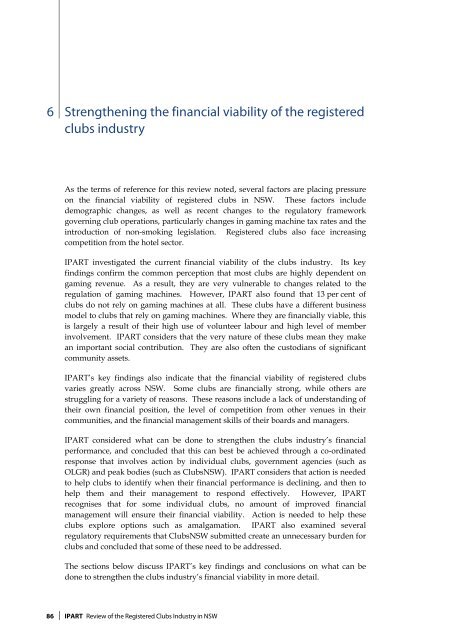Review of the Registered Clubs Industry in NSW - Clubs NSW
Review of the Registered Clubs Industry in NSW - Clubs NSW
Review of the Registered Clubs Industry in NSW - Clubs NSW
You also want an ePaper? Increase the reach of your titles
YUMPU automatically turns print PDFs into web optimized ePapers that Google loves.
6 Streng<strong>the</strong>n<strong>in</strong>g <strong>the</strong> f<strong>in</strong>ancial viability <strong>of</strong> <strong>the</strong> registered<br />
clubs <strong>in</strong>dustry<br />
6 Streng<strong>the</strong>n<strong>in</strong>g <strong>the</strong> f<strong>in</strong>ancial viability <strong>of</strong> <strong>the</strong> registered<br />
clubs <strong>in</strong>dustry<br />
As <strong>the</strong> terms <strong>of</strong> reference for this review noted, several factors are plac<strong>in</strong>g pressure<br />
on <strong>the</strong> f<strong>in</strong>ancial viability <strong>of</strong> registered clubs <strong>in</strong> <strong>NSW</strong>. These factors <strong>in</strong>clude<br />
demographic changes, as well as recent changes to <strong>the</strong> regulatory framework<br />
govern<strong>in</strong>g club operations, particularly changes <strong>in</strong> gam<strong>in</strong>g mach<strong>in</strong>e tax rates and <strong>the</strong><br />
<strong>in</strong>troduction <strong>of</strong> non-smok<strong>in</strong>g legislation. <strong>Registered</strong> clubs also face <strong>in</strong>creas<strong>in</strong>g<br />
competition from <strong>the</strong> hotel sector.<br />
IPART <strong>in</strong>vestigated <strong>the</strong> current f<strong>in</strong>ancial viability <strong>of</strong> <strong>the</strong> clubs <strong>in</strong>dustry. Its key<br />
f<strong>in</strong>d<strong>in</strong>gs confirm <strong>the</strong> common perception that most clubs are highly dependent on<br />
gam<strong>in</strong>g revenue. As a result, <strong>the</strong>y are very vulnerable to changes related to <strong>the</strong><br />
regulation <strong>of</strong> gam<strong>in</strong>g mach<strong>in</strong>es. However, IPART also found that 13 per cent <strong>of</strong><br />
clubs do not rely on gam<strong>in</strong>g mach<strong>in</strong>es at all. These clubs have a different bus<strong>in</strong>ess<br />
model to clubs that rely on gam<strong>in</strong>g mach<strong>in</strong>es. Where <strong>the</strong>y are f<strong>in</strong>ancially viable, this<br />
is largely a result <strong>of</strong> <strong>the</strong>ir high use <strong>of</strong> volunteer labour and high level <strong>of</strong> member<br />
<strong>in</strong>volvement. IPART considers that <strong>the</strong> very nature <strong>of</strong> <strong>the</strong>se clubs mean <strong>the</strong>y make<br />
an important social contribution. They are also <strong>of</strong>ten <strong>the</strong> custodians <strong>of</strong> significant<br />
community assets.<br />
IPART’s key f<strong>in</strong>d<strong>in</strong>gs also <strong>in</strong>dicate that <strong>the</strong> f<strong>in</strong>ancial viability <strong>of</strong> registered clubs<br />
varies greatly across <strong>NSW</strong>. Some clubs are f<strong>in</strong>ancially strong, while o<strong>the</strong>rs are<br />
struggl<strong>in</strong>g for a variety <strong>of</strong> reasons. These reasons <strong>in</strong>clude a lack <strong>of</strong> understand<strong>in</strong>g <strong>of</strong><br />
<strong>the</strong>ir own f<strong>in</strong>ancial position, <strong>the</strong> level <strong>of</strong> competition from o<strong>the</strong>r venues <strong>in</strong> <strong>the</strong>ir<br />
communities, and <strong>the</strong> f<strong>in</strong>ancial management skills <strong>of</strong> <strong>the</strong>ir boards and managers.<br />
IPART considered what can be done to streng<strong>the</strong>n <strong>the</strong> clubs <strong>in</strong>dustry’s f<strong>in</strong>ancial<br />
performance, and concluded that this can best be achieved through a co-ord<strong>in</strong>ated<br />
response that <strong>in</strong>volves action by <strong>in</strong>dividual clubs, government agencies (such as<br />
OLGR) and peak bodies (such as <strong>Clubs</strong><strong>NSW</strong>). IPART considers that action is needed<br />
to help clubs to identify when <strong>the</strong>ir f<strong>in</strong>ancial performance is decl<strong>in</strong><strong>in</strong>g, and <strong>the</strong>n to<br />
help <strong>the</strong>m and <strong>the</strong>ir management to respond effectively. However, IPART<br />
recognises that for some <strong>in</strong>dividual clubs, no amount <strong>of</strong> improved f<strong>in</strong>ancial<br />
management will ensure <strong>the</strong>ir f<strong>in</strong>ancial viability. Action is needed to help <strong>the</strong>se<br />
clubs explore options such as amalgamation. IPART also exam<strong>in</strong>ed several<br />
regulatory requirements that <strong>Clubs</strong><strong>NSW</strong> submitted create an unnecessary burden for<br />
clubs and concluded that some <strong>of</strong> <strong>the</strong>se need to be addressed.<br />
The sections below discuss IPART’s key f<strong>in</strong>d<strong>in</strong>gs and conclusions on what can be<br />
done to streng<strong>the</strong>n <strong>the</strong> clubs <strong>in</strong>dustry’s f<strong>in</strong>ancial viability <strong>in</strong> more detail.<br />
86 IPART <strong>Review</strong> <strong>of</strong> <strong>the</strong> <strong>Registered</strong> <strong>Clubs</strong> <strong>Industry</strong> <strong>in</strong> <strong>NSW</strong>
















